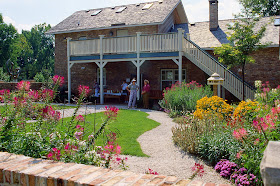It was another busy day with plenty of volunteers helping out at the gardens. My "historical tribute" today is for our English cottage garden which was developed in 1990 as the upgrades for the Rath Environmental Center (directly below) were being finished. This building was originally the Wilcox Sand & Gravel Company Office Building and had various uses between that function and dramatic re-purposing for RBG. Originally slated for demolition, Dr. Yahr (founder of RBG) championed saving the building and using it as our first visitor's center. This building housed our first gift shop, restrooms, office space, meeting room and ultimately a small solarium. The English cottage garden would be developed right behind the building as the first garden to be viewed after exiting the structure and it was the first of three gardens creating the "formal garden expanse" (also including the Italian formal garden and French formal garden). More on this garden later...
Our volunteers were numerous throughout the day. Kay and Patrea teamed up for garden clean-up and weeding this morning as did Eva and Kathy. All four ladies did a wonderful job. Dr. Gredler was out aerating various garden areas this morning which is a standard activity in April (and early October). Joe M. and Pat R. did a great job painting some of our last obelisks today and Pat C. was in for label "first aid" and inventory. Janice worked with the Chestnut House Volunteers on repotting many of our newly arrived trial plants this afternoon. Mary, Gena and Myrt did a nice job composting a portion of the shade garden and we also saw Hal R., Bill O., Maury, Dick P., John J., Steve L. and many others today. Jumbo Jim was also at the gardens with two RECAPPERS and they did a nice job on various tasks.
The grounds staff accomplished a wide range of tasks throughout the day. Pat mowed, secured obelisks and did some clean-up along the east parking lot area with Cindy. Cindy also tidied multiple areas throughout the gardens. Jenny went on a weeding and tidying binge and did some label inventorying as well. Cheryl was involved with tidying up the Japanese garden and other areas. She also did some composting near the gazebo. Terry and Big John rototilled, edged, flagged irrigation and bounced between myriad other duties. I had a presentation this morning for the Optimist Club which went well and juggled a wide range of outdoor and indoor tasks while accommodating lots of volunteers and visitors.
One of the first developments for the English cottage garden was the installation of brick walls to surround this intimate space. As a walled garden with an intended center portion of lawn and peripheral plantings, the intent of this garden was to expose newly arrived visitors to a variety of annuals, perennials and vegetables in mixed plantings for color and texture. Containers would be a big part of the garden as would a wall fountain. There is a story with all the brick (for the walls) you're seeing below and I think I'm accurate in relaying....Dr. Yahr saw a building being destroyed in Chicago that had the exact same brick (called Chicago Commons) as the Rath Environmental Center and arranged to have the brick preserved and hauled back to Janesville for immediate re-use for the English cottage garden walls. We had the help of many volunteers for the construction of this garden as well as assistance from the Wisconsin Conservation Corps (WCC) and volunteer craftsmen from the Jobs Bank Program that General Motors was providing at the time. The garden developed quickly and later added a copper cheese vat planter, dolphin wall fountain, more containers and additional modifications. Enjoy the shots below and note the change in pathways from a more linear arrangement to the circular pathway.
early brick wall construction
Harold Todd (deceased) leading the masonry projects
the start to a structure (perpendicular to the Rath Center) that would ultimately house our tools and equipment for the first 10 years of the gardens before the Horticulture Center was built
same as above
note the indentation in the center that would become the brick-faced, arched alcove seen below
note the lady fountain in the center in this later image (that structure was removed to accommodate the 2001 expansion and creation of the Parker Education Center)
more early wall work
same as above
the original gravel path layout
the gardens filling in nicely
same as above
more recent images (above and below) with circular pathway

















No comments:
Post a Comment